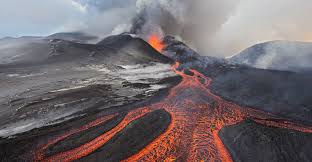Volcanic Eruption – Staying Prepared
If you live near a volcano, here’s how you can stay prepared.
Most of us have never and will never experience an volcanic eruption. These natural phenomena only occur in a few places in the world. However, news of a volcanic eruption travels all over the world.
There are a little over 1,300 active volcanoes in the world. Of that amount, about 45 continue to eruption and approximately 80 eruption each year. Fortunately, in many cases, no injuries occur. However, this is the result of advanced planning, emergency response procedures, and prompt response to directions.
If you ever found yourself faced with a potential volcanic eruption, what should you do? This article highlights how to prepare for a volcanic eruption.
Please note that this article does contain affiliate links. By purchasing any of the products discussed below through our website, we will gain a small commission that will go into costs associated with this website. Please continue reading and thanks for visiting.
What causes a volcanic eruption?
The explanation of volcanic eruptions can get very detailed. In simplest terms, volcanic eruptions happen when molten rock called magma rises to the top of the earth’s surface. As the magma rises, bubbles of gas form inside it. Runny magma erupts through openings or vents in the earth’s crust before flowing onto its surface as lava. If there is too much pressure, an explosion may occur.
To learn more about volcanic eruptions, visit BBC, which gave a very easy to understand explanation and video of why volcano eruptions occur.
Here’s another video explaining volcano eruptions:
Volcano Warning Levels
Like other natural disasters, there are warnings associated with volcanoes. Different countries have different ways to characterize it. For instance, in New Zealand, they use levels 0 to 5, with Level 5 being a major eruption. For the purposes of this article, we will use the United States nationwide volcano alert-level system.
The United States Geological Survey (USGS) alert system has two parts: 1) ranked terms to inform people on the ground about a volcano’s status and 2) ranked colors to inform the aviation sector about airborne ash hazards. This image highlights the different levels:
Green
Volcano is in typical, non-eruptive state or, after a change from a higher level, volcanic activity has ceased and volcano has returned to noneruptive background state.
Yellow
Volcano is exhibiting signs of elevated unrest above known background level or, after a change from a higher level, volcanic activity decreased significantly but continues to be closely monitored for possible renewed increases.
Orange
Volcano is exhibiting heightened or escalating unrest with increased potential of eruption, timeframe uncertain, or eruption is underlay with no or minor volcanic-ash emissions.
Red
Eruption is imminent with significant emission of volcanic ash into the atmosphere likely or eruption is underway or suspected with significant emission of volcanic ash into the atmosphere.
If a warning is given, be sure to listen to the alert-level and the instructions that follow.
Preparing for an eruption
As with any natural disaster, preparation can save a lot of time. The first thing to do is to develop an emergency plan. You might be instructed to evacuate or shelter in place. Having a plan in place for either scenario is a must.
In addition to having a plan, it is important to have essential items. These items should make up your go bag. These items should include:
- Food
- Water
- First Aid
- Power Supplies
- Lighting
- Shelter
- Fire extinguisher
- Important documents
- Activities for kids
Ready to make your emergency go bag?
Stay one step ahead of a disaster later by taking steps to prepare now.
Stay Informed
Before a volcanic eruption, there is usually activity that will let people know that danger is imminent. By listening to the authorities, you get important information such as whether you should shelter in place or evacuate. Keep up with reports on TV, internet, and the radio.
If action is instructed by the news reports, act decisively! If given instructions while evacuating, follow directions!
Prepare to Evacuate
If you are instructed to evacuate, follow the instructions of the authorities and leave the area. Be sure to take your go bag as you travel away from the impacted area to a safe location. Since hazardous conditions can be present such as ash, lava, and polluted area, be observant and careful.
The CDC gives valuable tips on what to do when preparing to evacuate. Here are their suggestions according to their website when preparing to evacuate:
- Tune in the radio or television for volcano updates.
- Listen for disaster sirens and warning signals.
- Review your emergency plan and gather your emergency supplies. Be sure to pack at least a 1-week supply of prescription medications.
- Prepare an emergency kit for your vehicle with food, flares, booster cables, maps, tools, a first aid kit, a fire extinguisher, sleeping bags, a flashlight, batteries, etc.
- Fill your vehicle’s gas tank.
- If no vehicle is available, make arrangements with friends or family for transportation, or follow authorities’ instructions on where to obtain transportation.
- Place vehicles under cover, if at all possible.
- Put livestock in an enclosed area. Plan ahead to take pets with you, but be aware that many emergency shelters cannot accept animals.
- Fill your clean water containers.
- Fill sinks and bathtubs with water as an extra supply for washing.
- Adjust the thermostat on refrigerators and freezers to the coolest possible temperature. If the power goes out, food will stay cooler longer.
Sheltering in Place
If you are instructed to shelter in place, do not try to leave your home. Continuing listening to the authorities via radio or television. The CDC gives the following recommendations:
- Keep listening to your radio or television until you are told all is safe or you are told to evacuate. Local authorities may evacuate specific areas at greatest risk in your community.
- Close and lock all windows and outside doors.
- Turn off all heating and air conditioning systems and fans.
- Close the fireplace damper.
- Organize your emergency supplies and make sure household members know where the supplies are.
- Make sure the radio is working.
- Go to an interior room without windows that is above ground level.
- Bring your pets with you, and be sure to bring additional food and water supplies for them.
- It is ideal to have a hard-wired (non-portable) telephone in the room you select. Call your emergency contact—a friend or family member who does not live near the volcano—and have the phone available if you need to report a life-threatening condition. Remember that telephone equipment may be overwhelmed or damaged during an emergency.

